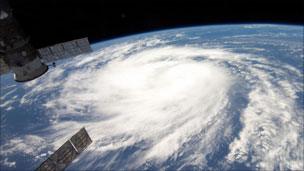Who, What, Why: How are hurricanes named?
- Published

Katia, the second hurricane of the season, is gaining strength in the Atlantic
The US is still clearing up after Irene, while dealing with Lee and keeping an eye on the looming threat of Katia. So how are hurricanes and other tropical cyclones named?
Hurricane Katia has gathered strength in the Atlantic just as Tropical Storm Lee has soaked Mississippi and whipped up wildfires in Texas.
And before the end of the year, the US and the Caribbean could have Tammy, Vince and Whitney blowing through their midst.
Putting human names, rather than numbers or technical terms, to tropical cyclones is intended to avoid confusion and make them easier to remember when issuing warnings. But who comes up with them?
Contrary to rumour, it's nothing to do with the names of politicians or, even more outlandishly, the people who died in the Titanic.
The list of names for the Atlantic's tropical cyclones, which are upgraded to hurricanes if they reach 74mph (119km/h), was originated in 1953 by the National Hurricane Center in Miami.
But it is maintained and updated by the World Meteorological Organization, an agency of the United Nations based in Geneva.
It has five tropical cyclone regional bodies around the world, and the one that covers the US and Caribbean is called the RA IV Hurricane Committee, external. It has 26 members.
The committee decides at an annual meeting, usually held in March or April, which storms from the previous year have been particularly devastating and therefore need to be "retired" and replaced.
This year it was farewell to Igor and Tomas, to be replaced by Ian and Tobias.
The list is alphabetical, so the first tropical cyclone of 2011 was called Arlene, the next Bret and so on.
Each year the names rotate to the next of six lists, and the first named storm of a season always begins with the letter "A".
The rotation policy means that the names of 2011 may be familiar to those who followed the weather closely in 2005. That year Katrina, which claimed nearly 2,000 lives in the US, was replaced by Katia, currently whipping up a storm a few hundred miles from Bermuda.
Koji Kuroiwa, chief of the tropical cyclones programme at the World Meteorological Organization, says the US military was the first to use people's names to denote storms, during World War II.
"They preferred to pick out names from girlfriends or wives or mothers. Most in those days were female names."
This principle was formally introduced in 1953, with men's names added in the 1970s.
Using personal names is intended to make it easier for people to understand forecasts and warnings, says Mr Kuroiwa, but the public sometimes likes to have its say.
"We have a lot of enquiries every year requesting, 'Please use my name or my wife's name or my daughter's name'.
"In the meantime, there's some negative comment, for example a woman named Irene who wasn't very happy."
In Victorian times, storms were named arbitrarily. An Atlantic storm that ripped off the mast of a boat named Antje in 1842 became known as Antje's hurricane.
Other hurricanes have been identified by their location, but their latitude and longitude was not easy to identify or communicate.
A 19th Century Australian forecaster, Clement Wragge, is reported to have amused himself by naming them after unpopular politicians. Hurricanes in the Caribbean region were once named after the saints' days on which they struck.
Nowadays, the names differ worldwide according to the region.
"They generally try to cover names which are in general usage, either in the US or the surrounding island nations in the Caribbean," says Julian Heming, tropical predictions scientist at the Met Office in the UK.
"So they include names which have a Hispanic feel as well, like Jose. In the Atlantic and East Pacific they use real people's names but there are different conventions in other parts of the world."
In the western Pacific, where Typhoon Talas has killed scores of people this week, they use names of objects and descriptive adjectives, says Mr Heming. They include Son-Tinh, Faxai and Noru.
"The key feature is that it's a name that people can remember and identify. Previously that region had names that were very American/English and it was decided 10 years ago that they needed to be more appropriate to the region."
Five letters - Q, U, X, Y and Z - are not used in the Atlantic list due to a lack of names, so there are a maximum of 21 named storms in one year before the list is exhausted.
"If the remainder of the season is very active, it's not out of the question that we'll have to go through the same process as 2005," says Mr Heming, "and start using letters from the Greek alphabet."